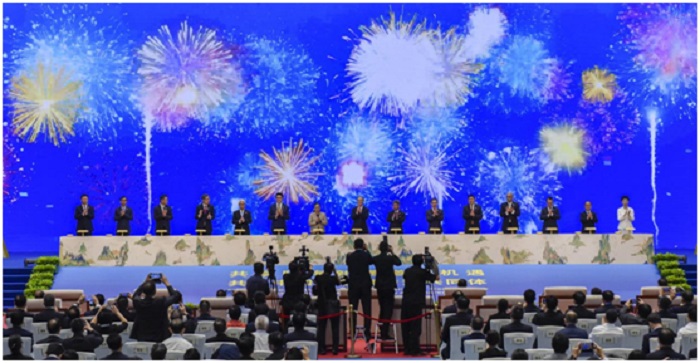



China and ASEAN have achieved remarkable progress in bilateral trade since the two sides commenced their dialogue relations in 1991.
Over the past 30 years, their trade volume expanded 85 times, with cumulative mutual investment exceeding $310 billion. Besides, the two sides have jointly built over 20 economic and trade cooperation zones.
The blooming China-ASEAN relations have grown into the most successful and vibrant model for cooperation in the Asia-Pacific and an important engine driving the successful development of East Asia.
According to Chinese customs, the bilateral trade between China and ASEAN grew to $685.28 billion last year from $8.36 billion 30 years ago, expanding 16.5 percent annually on average, 3.4 percentage points higher than China’s trade growth in the same period.
In breakdown, exports rose from $4.45 billion to $383.68 billion, with an average yearly growth of 16.4 percent, while imports rose from $3.91billion to $301.6 billion, growing 16.5 percent on average each year.
Last year, ASEAN became China’s top trading partner. China also maintained ASEAN’s largest trading partner for the 12th year in a row.
During the past three decades, the trade structure between the two sides has been constantly optimized. In 2020, China exported $204.48 billion worth of mechanical and electronic products to ASEAN. The exports of textiles, steel, mobile phones, ships, furniture, fruits, automobiles, and medical products were also on the rise. ASEAN’s exports of primary and resource products to China, including agricultural products, rubber, petro, natural gas, and coal, maintained robust growth.
The 2020 China-ASEAN Trade Index, released by China’s General Administration of Customs (GAC) on Sept. 11, stood at 241.09, increasing 19.64 percent and 141.09 percent from 2019 and 2010, respectively.
Since the establishment of the China–ASEAN Free Trade Area, China’s customs has taken the lead in completing negotiations with ASEAN to upgrade the rules of origin and has smoothly implemented them, as well as helping foreign-trade enterprises thoroughly enjoy the policy of tariff reduction. According to the GAC, over 90 percent of the commodities between the two sides are traded tariff-free, with a total tax reduction of 314.9 billion yuan ($48.85 billion).
With the concrete steps of the Belt and Road construction, a batch of major infrastructure projects have been implemented, which effectively raised the level of connectivity between China and ASEAN countries and made bilateral cross-border logistics more unimpeded.
The GAC said the New International Land-Sea Trade Corridor, on which freight trains started carrying commodities between southwest China’s Chongqing municipality and Singapore via Guangxi Zhuang autonomous region in 2017, is now expanded to a six-route transport network that makes over 10 trips every day, from only one each week in the early days. It has become a significant channel of exportation in western China and the fastest and most convenient passage linking China and ASEAN under the the Regional Comprehensive Economic Partnership framework.
At present, the New International Land-Sea Trade Corridor is connected with the China-Europe freight train service and the two have carried 1,504 twenty-foot equivalent units this year, fully releasing the trade potential of China and ASEAN.
Statistics released by Chinese customs indicated that the total trade volume with ASEAN of the 14 provinces, autonomous regions, and municipalities along the New International Land-Sea Trade Corridor reached $81.22 billion in the first eight months this year, up 28.7 percent and lifting China-ASEAN trade growth by 4.4 percentage points.
Vice Minister of Commerce Ren Hongbin noted that China is willing to further strengthen the alignment between Chinese and ASEAN development strategies, promote high-quality development of the Belt and Road, and enhance all-round connectivity to jointly bring bilateral economic and trade partnership onto a newer and higher level.
Chinese and ASEAN enterprises are generally optimistic about future economic and trade cooperation between the two countries and are confident about benefiting from it, said a report issued by PwC at the China-ASEAN Expo on Sept. 11.
The two sides are expected to keep deepening cooperation in multiple areas, said Gabriel Wong, PwC’s China Corporate Finance Leader.


The Executive and members of the.


The Acting Director, FCT Directorate of.


President Bola Ahmed Tinubu has been.



Barely a month after resignation of.


An Abuja based Legal Practitioner, Osuagwu.



Convener of Equitable Remedy, Mrs. Magaret.


Contractors handling the contract for city.


Nigerian government may have concluded plans.


The Diplomatic Correspondents Association of Nigeria.


A rights group, “Follow Me Talk.
Leave a Comment